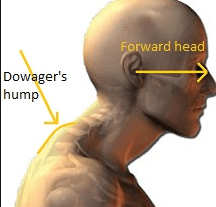Back and Joint Pain
Dowager’s Hump: An Unsightly Bump At The Base Of The Neck
What Is A Dowager’s Hump?
A dowager’s hump is the common name given to a hump that can form at the base of the neck. Traditionally this “hump” is mostly frequently seen in older women, but is also seen in men and occasionally younger adults. Medically rounding of the spine is referred to as a postural kyphosis and a “dowager’s hump” is called a hyperkyphosis. Hyperkyphosis is characterized by significant roundness and fatty deposits at the lower region of the neck. Contrary to its visual appearance the dowager’s hump itself is not necessarily painful, however the presence of a hyperkyphosis can play a major role in the individual experiencing neck, shoulder, and upper back pain due to the position the head is placed into and the resulting strain on any supporting soft tissues and joints. In addition to any associated pain and discomfort an individual with a dowager’s hump may experience, a hyperkyphosis causes many to become embarrassed about their appearance with the cosmetic impact being the greatest issue. The image shown below demonstrates a hyperkyphosis, a position characterized by forward head posture with a loss of the natural spinal curve in the neck. Accompanying this flattened cervical spine and fwd head posture is an enlarged prominence, forward rounding at the base of the neck and the presence of fatty tissue deposit.
What Causes A Hyperkyphosis?
Poor posture over an extended time plays a roll, where specifically a forward head posture is the cause of this condition. When your head sits forward from its normal neutral anatomic position there is increased stress placed on to the base of the neck. Subsequently as a result of prolonged forward head posture and the resulting increased stress on the base of the neck, connective tissue, bone and joint changes occur. What occurs over time is the accumulation of thickening of these tissues in an attempt to support this extra load through the neck that has been applied over an extended period of time leads, ultimately leading to the formation of the recognizable hump. Similar to developing callous tissue on your hands or feet from the repetitive rubbing that may occur in shoes, or associated with manual work or lifting activities at the gym, the skin of the hands or feet adapt over time by laying down more and more tissue leading to callouses. Not exactly the same but a comparable principle, the exposure of the body to prolonged poor posture over years in some people contributes to changes around the base of the neck.
In my Sydney physio practice I noticing that forward head posture is becoming increasingly more prevalent in progressively younger and younger individuals. Possibly at least in part as a result of increased use of electronic devices, such screen time subsequently causes the user not only increase their overall time spent in forward head postures but often curl up even more when operating the devices than simply watching TV, on a desktop computer, or reading a book.
- In the older population with low bone density more severe cases of hyperkyphosis may have vertebral fractures and degenerative discs, these changes can cause segments of the spine to “collapse”, further worsening the appearance of the “hump” and potentially causing more discomfort along the way.
Disclaimer: Sydney Physio Clinic provides this information as an educational service and is not intended to serve as medical advice. Anyone seeking specific advice or assistance on Dowager’s Hump: An Unsightly Bump At The Base Of The Neck should consult his or her physiotherapist, general practitioner or otherwise appropriately skilled practitioner.



